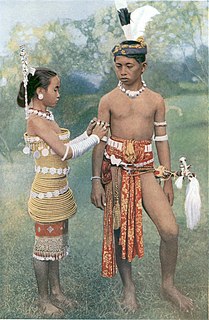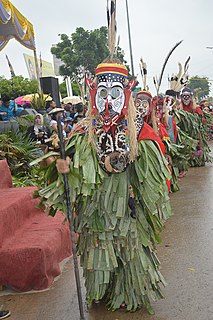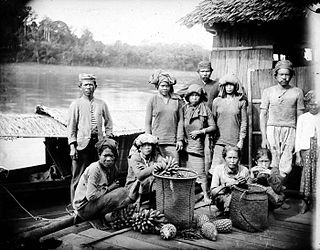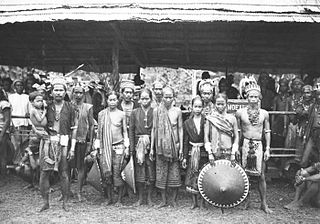Related Research Articles

The Dayak or Dyak or Dayuh are one of the native groups of Borneo. It is a loose term for over 200 riverine and hill-dwelling ethnic groups, located principally in the central and southern interior of Borneo, each with its own dialect, customs, laws, territory, and culture, although common distinguishing traits are readily identifiable. Dayak languages are categorised as part of the Austronesian languages. The Dayak were animist in belief; however, since the 19th century there has been mass conversion to Christianity as well as Islam due to the spreading of foreign religions.

The Iban language is spoken by the Iban, a branch of the Dayak ethnic group, who live in Brunei, the Indonesian province of West Kalimantan and in the Malaysian state of Sarawak. It belongs to the Malayic languages, a Malayo-Polynesian branch of the Austronesian language family.

West Kalimantan is a province of Indonesia. It is one of five Indonesian provinces comprising Kalimantan, the Indonesian part of the island of Borneo. Its capital city is Pontianak. The province has an area of 147,307 km2, and had a population of 4,395,983 at the 2010 Census and 5,414,390 at the 2020 Census. Ethnic groups include the Dayak, Malay, Chinese, Javanese, Bugis, and Madurese. The borders of West Kalimantan roughly trace the mountain ranges surrounding the vast watershed of the Kapuas River, which drains most of the province. The province shares land borders with Central Kalimantan to the southeast, East Kalimantan to the east, and the Malaysian territory of Sarawak to the north.

South Kalimantan is a province of Indonesia. It is the smallest province in Kalimantan, the Indonesian territory of Borneo. The provincial capital was Banjarmasin until 15 February 2022 when it was legally moved to Banjarbaru. The population of South Kalimantan was recorded at just over 3.625 million people at the 2010 Census, and at 4.07 million at the 2020 Census. One of the five Indonesian provinces in Kalimantan, it is bordered by the Makassar Strait in the east, Central Kalimantan in the west and north, the Java Sea in the south, and East Kalimantan in the north. The province also includes the island of Laut, located off the eastern coast of Kalimantan. The province is divided into 11 regencies and 2 cities. South Kalimantan is the traditional homeland of the Banjar people, although some parts of East Kalimantan and Central Kalimantan are also included in this criteria. Nevertheless, South Kalimantan, especially the former capital city Banjarmasin has always been the cultural capital of Banjarese culture. Many Banjarese have migrated to other parts of Indonesia, as well as neighbouring countries such as Singapore and Malaysia. In addition, other ethnic groups also inhabit the province, such as several groups of the Dayaks, who mostly live in the interior part of the province, as well as the Javanese, who mostly migrated from Java due to the Transmigration program which dated from the Dutch colonial era.

The Ibans or Sea Dayaks are a branch of the Dayak peoples on the island of Borneo in South East Asia. Dayak is a title given by the westerners to the local people of Borneo island. It is believed that the term "Iban" was originally an exonym used by the Kayans, who – when they initially came into contact with them – referred to the Sea Dayaks in the upper Rajang river region as the "Hivan".

Bidayuh is the collective name for several indigenous groups found in southern Sarawak, Malaysia and northern West Kalimantan, Indonesia, on the island of Borneo, which are broadly similar in language and culture. The name Bidayuh means 'inhabitants of land'. Originally from the western part of Borneo, the collective name Land Dayak was first used during the period of Rajah James Brooke, the White Rajah of Sarawak. At times, they were also lesser referred to as Klemantan people. They constitute one of the main indigenous groups in Sarawak and West Kalimantan and live in towns and villages around Kuching and Serian in the Malaysian state of Sarawak, while in the Indonesian province of West Kalimantan they are mainly concentrated in the northern Sanggau Regency. In Sarawak, most of Bidayuh population can be found within 40 km of the geographical area known as Greater Kuching, within the Kuching and Serian Division. They are the second-largest Dayak ethnic group in Sarawak after the Iban and one of the major Dayak tribes in West Kalimantan.
Barito may refer to:
Selako, also known as Salako, Silakau, Selakau, Selako Dayaks, Bidayuh Selako, Kata Diri' or Damea is an indigenous Dayak ethnic group that lives in the westernmost part of Borneo island. In Indonesia, they are found in districts such as Tujuhbelas, Samalantan, Paloh, Tebas, Telukkeramat and Sejangkung of Sambas Regency, and Bengkayang Regency, West Kalimantan. While in Malaysia, most Selakos are settled in areas such as Sematan settlement in Lundu, Sarawak. They are classified as part of the Bidayuh tribe linguistically and geographically. They speak Selako language, which is a branch of Malayic languages instead of Bornean or Land Dayak like most Dayaks, besides Selako they also speak Malaysian and Sarawak Malay in Malaysia and Indonesian in Indonesia. Many Selakos are Christians, they are mostly Anglicans, Bornean Evangelicals and Roman Catholics following missionary work in the 19th century.

Hudoq is a masked dance performed during Erau harvest thanksgiving festival of many of sub-groups of the Dayak ethnic group of East Kalimantan province, Indonesia. The Hudoq culture and performance is indigenous among Dayak population of East Kalimantan province, and it is said to have originated from Mahakam Ulu Regency.

Kutai is a historical region in East Kalimantan, Indonesia on the island of Borneo and is also the name of the native ethnic group of the region, numbering around 300,000 who have their own language known as the Kutainese language which accompanies their own rich history. Today, the name is preserved in the names of three regencies in East Kalimantan province which are the Kutai Kartanegara Regency, the West Kutai Regency and the East Kutai Regency with the major river flowing in the heart of the region known as the Mahakam River. Kutai is known to be the place of the first and oldest Hindu kingdom to exist in Indonesia, the Kutai Martadipura Kingdom which was later succeeded by the Muslim Kutai Kartanegara Sultanate.
The Land Dayak languages are a group of dozen or so languages spoken by the Bidayuh Land Dayaks of Borneo.

Ma'anyan, Dayak Maanyan or Eastern Barito Dayak people are a sub-ethnic group of the Dayak people indigenous to Borneo. They are also considered as part of the east Barito Dusun group with the name Dusun Ma'anyan. According to J. Mallinckrodt (1927), the Dusun people group is part of the Ot Danum people cluster, although later that theory was disproved by A. B. Hudson (1967), who argues that the Ma'anyan people are a branch of the Barito family. The Ma'anyan people who are often referred to as Dayak people are also referred to as Dayak Ma'anyan. The Dayak Ma'anyan people inhabit the east side of Central Kalimantan, especially in the East Barito Regency and parts of South Barito Regency which are grouped as Ma'anyan I. The Dayak Ma'anyan people also inhabit the northern parts of South Kalimantan, especially in Tabalong Regency which refers to the Dayak Warukin people. The Dayak Balangan people or Dusun Balangan people which are found in the Balangan Regency and the Dayak Samihim people that are found in the Kotabaru Regency are grouped together with the Dayak Ma'anyan people group. The Dayak Ma'anyan people in South Kalimantan are grouped as Ma'anyan II.
Lawangan or Luangan people are a sub-ethnic of the Dayak Dusun people group, sometimes also referred to as Dusun Lawangan or Dayak Lawangan. The Lawangan people inhabit the eastern side of Central Kalimantan and West Kutai Regency, East Kalimantan, Indonesia. In Tabalong Regency, South Kalimantan, the Lawangan people can be found only in Binjai village. They speak Lawangan language.

Bakumpai or Baraki are indigenous people of Borneo and are considered as a sub-ethnic group of the Dayak Ngaju people group with Islamic background. The Bakumpai people first occupy along the Barito riverbanks in South Kalimantan and Central Kalimantan, from Marabahan to Puruk Cahu, Murung Raya Regency. The Bakumpai people first appeared as a newly recognized people group in census 2000 and were made up of 7.51% of Central Kalimantan population, which before this the Bakumpai people were considered as part of the Dayak people in a 1930 census.

Sambas Regency is the most northerly regency in West Kalimantan Province of Indonesia. The regency is one of the original regencies in West Kalimantan. It covers 6,394.70 km2, and had a population of 496,120 at the 2010 Census and 629,905 at the 2020 Census. The principal town lies at Sambas.
Kendayan, or Salako (Selako), is a Malayic Dayak language of Borneo. The exact number of speakers remains unknown, but is estimated to be around 350,000.
Remun, or Milikin, is an Ibanic Dayak language of Borneo.

Mualang are an indigenous people of West Kalimantan from the Dayak group and a sub-ethnic of the Iban people. They speak the Mualang language and they are mostly concentrated in areas in the Sekadau Regency and Sintang Regency of West Kalimantan, Indonesia. The specific districts where the Mualang people live include:
- Belitang Hilir district, Sekadau
- Belitang district, Sekadau
- Belitang Hulu district, Sekadau
- Sepauk, Sintang and its surrounding region

Bahau people is a sub-ethic group of the Dayak people who inhabit West Kutai Regency (9.3%), East Kalimantan, Indonesia.

The Apo Kayan people are one of the Dayak people groups that are spread throughout Sarawak of Malaysia, East Kalimantan and North Kalimantan of Indonesia. The earliest Apo Kayan people are from the riverside of the Kayan River, Bulungan Regency, East Kalimantan, Indonesia. According to the Apo Kayan Dayak legend, the Kayan people are the forefathers of which all smaller sub-ethnic Dayak people that are found along the Kayan River came from. Today, the population of the Apo Kayan people are estimated about 64,900.
References
- ↑ Mualang at Ethnologue (18th ed., 2015) (subscription required)